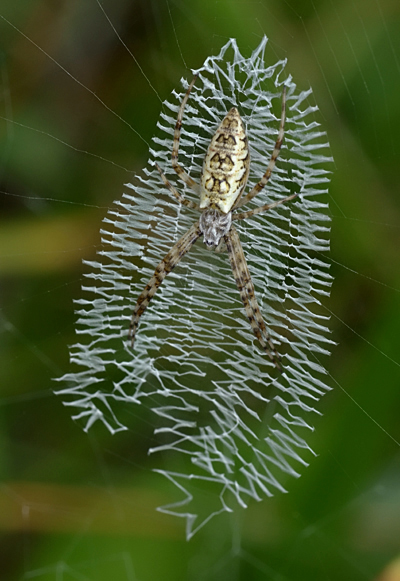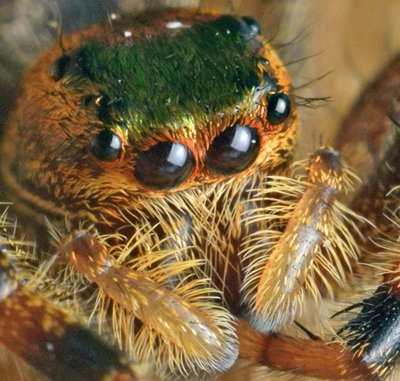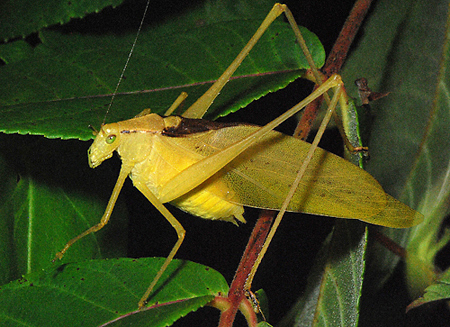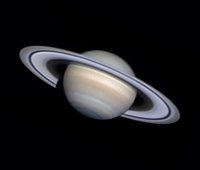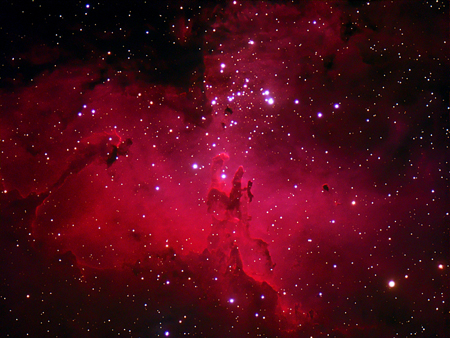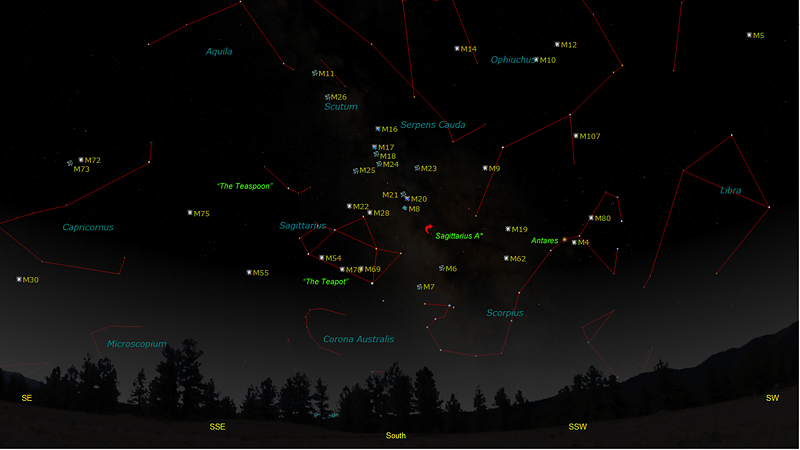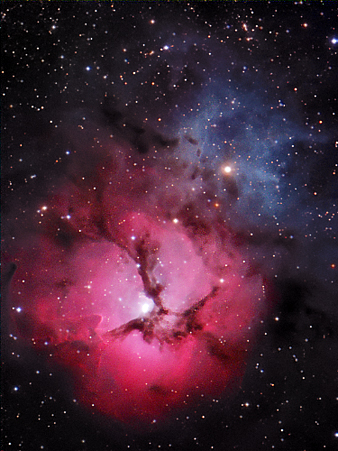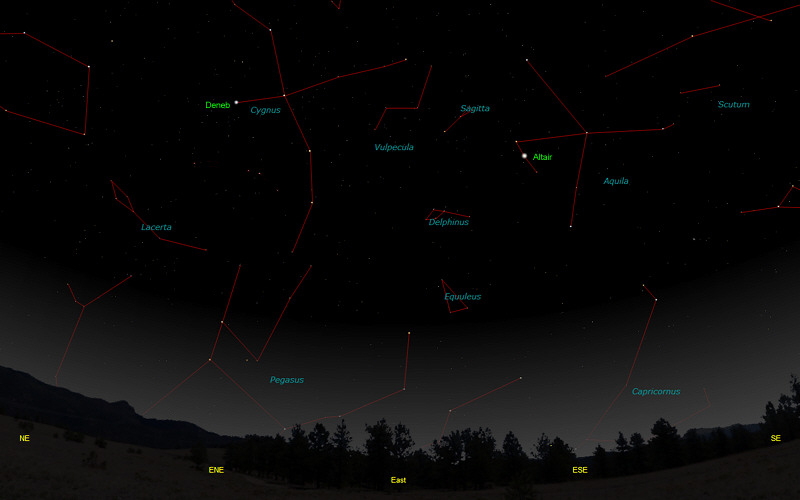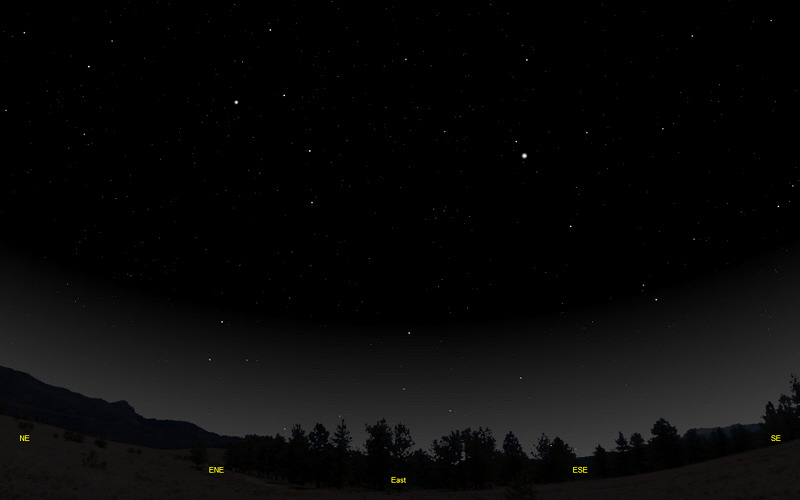The purpose of this feature is to give scout leaders, educators and naturalists an idea of some of the natural events coming up each month. We will try to cover a variety of natural events ranging from sky events to calling periods of amphibians, bird and mammal watching tips, prominent wildflowers and anything else that comes to mind. We will also note prominent constellations appearing over the eastern horizon at mid-evening each month for our area for those who would like to learn the constellations. If you have suggestions for other types of natural information you would like to see added to this calendar, let us know! Note: You can click on the hyperlinks to learn more about some of the featured items. To return to the Calendar, hit the "back" button on your browser, NOT the "back" button on the web page. All charts are available in a "printer friendly" mode, with black stars on a white background. Left clicking on each chart will take you to a printable black and white image. Please note that images on these pages are meant to be displayed at 100%. If your browser zooms into a higher magnification than that, the images may lose quality. Though we link book references to nationwide sources, we encourage you to support your local book store whenever possible. Notes and Images From June 2014
This time of year we sometimes come across young spiders that look very unlike their adult counterparts. At right is a young Black and Yellow Argiope that we found beside the path to the observatory. Many people are familiar with the large black and yellow adult females that are conspicuous in late summer and fall. We thought this might be a different species of Argiope, but in checking it out found it to be a young Black and Yellow Argiope. The species name is Argiope aurantia. The etymology of the genus is said to mean "gilded silver-face." The genus is noted for the zig-zag dense inner portion of the web, sometimes referred to as the stabilimentum. The purpose of this part of the web is still under debate. According to one source, only spiders active during the day construct the stabilimentia, so it may be a sort of visual cue. It may, as the name implies, be reinforcement. The spiders eat this part of the web each night and weave it again each morning. Young spiders are said to construct a larger stabilimentum than the adults. To give a sense of scale, the vertical dimension of the stabilimentum on the web at right measures about 1-1/4 inches.
At left is one of the the Golden Jumping Spiders that are residents at the new observatory. This one is often found in the southeast corner of the observatory, but it sometimes appears on parts of the telescope mount. On June 17th it jumped onto my t-shirt while I was working. I put it in a small container for a few minutes while I finished up, then put it back on the observatory wall and photographed it. Afterwards it disappeared back into a small hole. According to Wikipedia, the jumping spider family (Salticidae) contains more than 500 described genera and about 5,000 described species, making it the largest family of spiders with about 13% of all species.
Summer at our farm means a constant nighttime chorus of Cope's Gray Treefrogs. We see them everywhere, not only near our pond, but also foraging in our shrubbery and on the side of our house. One used a small crevice in my observatory for several days this month to spend the daylight hours. We photographed the treefrog at right beneath our front porch light on June 18th. It seemed to be doing quite well foraging for insects attracted to the light. One species of treefrog we were not expecting to hear on our Tennessee Amphibian Monitoring Program route this month was a Green Treefrog. We've been doing the route over ten years now, and this is the first time we've heard this species. Green Treefrogs were traditionally a west Tennessee species but in the last ten years or so they have expanded their range statewide. This could be related to warming temperatures, and may or may not be a good thing. Sometimes new species moving into an area will out-compete an established species for available resources. As beautiful as the Green Treefrog is, we would hate to hear the raucous chorus of gray treefrogs fade from our Tennessee nights.
We heard our first Oblong-winged Katydid for the year on June 30th. These members of the false katydid family have a single note that sounds a little like a match being struck. You can listen to one calling here with a chorus of Northern Cricket Frogs calling in the background. The katydid calls one time about three quarters of the way through the recording. Oblong-winged Katydids come in three color forms; green, yellow and rarely, pink. We have never seen the pink form, but the yellow form is quite striking. Listen also for the first Northern True Katydids.
Sky Events for July 2014: Somewhat ironically to some, the Sun is at aphelion, its farthest distance from the Sun in 2014, on July 3rd. Evening Sky: You may be able to spot Jupiter very low in the western sky in Gemini at dusk at the beginning of July. It will sink into the solar glare early in the month. Mars keeps getting fainter and smaller in the eyepiece as the distance between Earth and Mars increases. At the beginning of the month, look for it in Virgo about 37degrees above the southwest horizon at dusk.
Saturn remains in Libra. Look for it due south at dusk, about 40 degrees above the horizon, at the beginning of the month. The rings are now tilted to around 21 degrees from edge-on, giving a wonderful view of the ring system in any size telescope. Morning Sky: Venus continues to shine in the dawn sky during July. Look for it about 16 degrees above the eastern horizon about 30 minutes before sunrise. Look for Mercury below and to the left of Venus in the morning twilight from the second week of July onward. The fleet-footed planet reaches greatest elongation on July 12th. Summer Messier Objects: Looking south on a clear midsummer night yields a Summer Messier Objects: Looking south on a clear midsummer night yields a treasure trove of Messier clusters and nebulae. The illustration below is made for July 22nd at 10:45pm. You will want a clear, moonless evening far from city lights. First, look for Antares, the red giant that marks the heart of Scorpius, the Scorpion. The name Antares means, "rival of Mars." See if you can trace the tail of the scorpion down almost to the horizon, then back up to the two close stars that mark the stinger. These two stars are sometimes called the "cat's eyes." Due south look for the stars of Sagittarius. The brighter stars form an asterism known as "the teapot." Above the handle of the teapot you can see the four stars that form the asterism known as "the teaspoon." In a dark sky, the clouds of the Milky Way seem to boil out of the spout of the teapot. Above and to the right of the spout of the teapot is the radio source Sagittarius A*. It marks the center of our galaxy. There an enormous black hole with the mass of around 4 million times the mass of the Sun is thought to feed on any stars unlucky enough to wander too close. Nothing unusual is seen visually at this spot, but it's fun to imagine the beast within. This is a beautiful area to scan with binoculars, with many clusters and nebulae. See how far you can trace the Milky Way across the sky (easier if you're far away from city lights). Compare your view of the Milky Way to the image of the edge-on galaxy NGC 4565 we made in April of 2010.
Some of our favorite Messier objects reside in this part of the sky. One of the things that inspired me to build a 6 inch reflecting telescope in high school was an illuminated slide of the Eagle Nebula, M16, that was made by the 200" inch telescope on Palomar Mountain. You won't see the bright colors of these nebulae in a small telescope - the eye is very poor at detecting color at these very low light levels. But it's fun to try to spot the faintly glowing cloud. Another favorite is the Swan Nebula, M17. Here you can see a faint "swan" swimming in a pretty star field. You might also see if you can spot the dark lanes in the Trifid Nebula, M20. A nebula filter will help see detail, but will also tend to alter the appearance of the stars in the field. Above the spout of "the teapot" is Messier 8, the Lagoon Nebula. Don't leave this area without looking at the magnificent globular cluster Messier 22. Look for it slightly above and to the left of the star at the top of the teapot's "lid". Constellations: The first pair of charts below shows the sky looking east at 10:00pm CDT on July 15th. The first chart shows the sky with the constellation outlined and names depicted. Star and planet names are in green. Constellation names are in blue. The second view shows the same scene without labels. Prominent constellations this month in the eastern sky are Cygnus, the Swan, with its bright star Deneb, and Aquila, the Eagle, with its bright star Altair. Below and to the left of Altair is the constellation of Delphinus, the Dolphin, looking like it's leaping over the eastern horizon. Above Delphinus look for the arrow-like form of Sagitta, the Arrow. Between Sagitta and Cygnus lie the faint stars of Vulpecula, the Fox.
On Learning the Constellations: We advise learning a few constellations each month, and then following them through the seasons. Once you associate a particular constellation coming over the eastern horizon at a certain time of year, you may start thinking about it like an old friend, looking forward to its arrival each season. The stars in the evening scene above, for instance, will always be in the same place relative to the horizon at the same time and date each July. Of course, the planets do move slowly through the constellations, but with practice you will learn to identify them from their appearance. In particular, learn the brightest stars (like Deneb and Altair in the above scene), for they will guide you to the fainter stars. Once you can locate the more prominent constellations, you can "branch out" to other constellations around them. It may take you a little while to get a sense of scale, to translate what you see on the computer screen or what you see on the page of a book to what you see in the sky. Look for patterns, like the stars that make up the constellation Cygnus. The earth's rotation causes the constellations to appear to move across the sky just as the sun and the moon appear to do. If you go outside earlier than the time shown on the charts, the constellations will be lower to the eastern horizon. If you observe later, they will have climbed higher. As each season progresses, the earth's motion around the sun causes the constellations to appear a little farther towards the west each night for any given time of night. If you want to see where the constellations in the above figures will be on August 15th at 10:30pm CDT, you can stay up till 12:30am CDT on July 15th and get a p review. The westward motion of the constellations is equivalent to two hours per month. Recommended: Sky & Telescope's Pocket Star Atlas is a beautiful, compact star atlas. A good book to learn the constellations is Patterns in the Sky, by Hewitt-White. You may also want to check out at H. A. Rey's classic, The Stars, A New Way to See Them. For skywatching tips, an inexpensive good guide is Secrets of Stargazing, by Becky Ramotowski. A good general reference book on astronomy is the Peterson
Field Guide,
A Field Guide to the Stars and Planets, by Pasachoff. The book retails for around $14.00. Starry Night has several software programs for learning the night sky. Visit the Starry Night web site at www.starrynight.com for details. Virtual Moon Atlas is a terrific way to learn the surface features of the Moon. And it's free software. You can download the Virtual Moon Atlas here. Cartes du Ciel (described in the monthly notes above) is a great program for finding your way around the sky. It is also free, and can be downloaded here. Apps: We really love the Sky Safari Pro application described here. For upcoming events, the Sky Week application is quite nice. Both apps are available for both I-phone and Android operating systems. The newest version, Sky Safari 4, is available here.
Amphibians:
July’s frogs and toads are much like June’s. Listen for Cope's Gray Treefrogs, Gray Treefrogs, Bird-Voiced Treefrogs, Green Treefrogs and Barking Treefrogs. Northern Cricket Frogs and Southern Cricket Frogs call a lot during July, and the calls of Bullfrogs and Green Frogs fill the night air. After summer thunderstorms listen for the high, insect-like call of the Eastern Narrowmouth Toad and the strange-sounding Eastern Spadefoot. Be sure to look closely at young toads you encounter. Sometimes we find young Eastern Spadefoots foraging during the day. A young Eastern Spadefoot will have vertical pupils, a tiny spade on its rear feet and will often have some red warts, even when only a fraction of an inch long. A hand lens helps to see these features (or turn your binoculars around and use them for a magnifying glass.) Recommended: The Frogs and Toads of North America, Lang Elliott, Houghton Mifflin Co.
Archives (Remember to use the back button on your browser, NOT the back button on the web page!) Natural Calendar February 2014 Natural Calendar December 2013 Natural Calendar November 2013 Natural Calendar September 2013 Natural Calendar December 2012 Natural Calendar November 2012 Natural Calendar September 2012 Natural Calendar February 2012 Natural Calendar December 2011 Natural Calendar November 2011 Natural Calendar September 2011 Natural Calendar February 2011 Natural Calendar December 2010 Natural Calendar November 2010 Natural Calendar September 2010 Natural Calendar February 2010 Natural Calendar December 2009 Natural Calendar November 2009 Natural Calendar September 2009 Natural Calendar February 2009 Natural Calendar December 2008 Natural Calendar November 2008 Natural Calendar September 2008 Natural Calendar February 2008 Natural Calendar December 2007 Natural Calendar November 2007 Natural Calendar September 2007 Natural Calendar February 2007 Natural Calendar December 2006 Natural Calendar November 2006 Natural Calendar September 2006 Natural Calendar February 2006
Natural Calendar December 2005
Natural Calendar November 2005
Natural Calendar September 2005
Natural Calendar February 2005
Natural Calendar December 2004
Natural Calendar November 2004
Natural Calendar September 2004
Natural Calendar February 2004
Natural Calendar December 2003
Natural Calendar November 2003
Natural Calendar September 2003 Natural Calendar February 2003 Natural Calendar December 2002 Natural Calendar November 2002 Nature Notes Archives: Nature Notes was a page we published in 2001 and 2002 containing our observations about everything from the northern lights display of November 2001 to frog and salamander egg masses. Night scenes prepared with The Sky Professional from Software Bisque All images and recordings © 2014 Leaps |
||||||||||||||||
